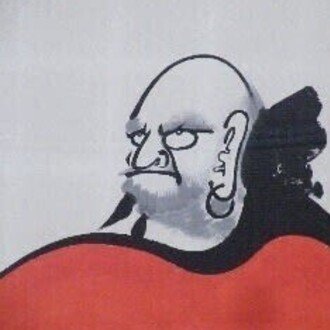
たかが茶の稽古で、禅問答がはじまる 【京都国立近代美術館-京の大家と知られざる大坂画壇】 Zen questions and answers begin with a tea lesson
以前、煎茶の稽古をしていた折に、毎回の稽古に欠かせない稽古必須の教科書のようなものがあった。煎茶概論のテキストや淹れ方の手引きではなく、それは床の間に掛けられていた「掛軸」だった。
Before, when I was practicing sencha, there was something like a textbook that was indispensable for each lesson. It was not a text of an introduction to sencha or a guide to brewing, but a "hanging scroll" hung at the Tokonoma.
一茶庵宗家独特の教示法なのか、佃宗匠の教授法なのかはわからないが、掛軸に描かれている絵や賛(漢詩など)を紐解いていく稽古だった。絵や漢詩については門外漢の我々は、稽古を始めたころは頭を抱えることばかり。その稽古の時間が、日常にない貴重なものに思えてくるには少々時が要した。我われにとって解らないことだらけのことに、光明の一矢だったのが “想像する” という誰しもが備わっている能力を使うことだった。
I don't know if it is a teaching method peculiar to the Issa-an Soke or a teaching method of Tsukuda sosho, but it was a practice to unravel the pictures and chinese poetry drawn on the hanging scroll. As for paintings and Chinese poetry, we, who are outsiders, just have a headache when we start practicing. It took some time for the training time to seem to be a precious thing that is not in everyday life. All that we don't understand is to use the ability of everyone to "imagine".
とくに漢詩の文字が崩されて読めない、また意味が分からない中で、なにを頼りにするかは、解る文字を探すことから始まった。たとえば30文字ある中で3文字でも解れば何とかなるという思いで。それからが、我われの持ちあわせている想像力(ええ加減)に頼り詩の意味を想像するのである。
Especially when the characters of Chinese poetry were broken and could not be read, and we didn't understand the meaning, what to rely on started with searching for the characters that we could understand. For example, I thought that if we could understand even 3 letters out of 30 letters, we would be able to do something about it. After that, we rely on our imagination (yes, yeah) to imagine the meaning of poetry.
その想像の、一つの参考文献がお軸に描かれてある「絵」である。文字だけでは全く理解不能だが、絵の内容を観て想像を膨らませる。察するのである。それでも正解を導きだせるはずがない。それからが師匠と弟子たちの禅問答のようなことが始まる。
One of the references of that imagination is the "picture" drawn on the axis. It's completely incomprehensible only with letters, but you can expand your imagination by seeing the contents of the picture. we guess. Still, the correct answer cannot be derived. Then things like the Zen questions and answers of the master and the disciples begin.
無茶でとんでもない質問を投げかけても、宗匠は笑って返球してくれる。その返球の中にヒントがある。毎回この繰り返しで稽古は進んだ。お陰で煎茶の淹れ方や作法は身につかなかった。しかしながら、唯一、身についたと思われるのがお茶の味。その日のお軸の意味から導きだした茶の味の違いが理解できるようになったのは唯一の成果だったような気がする。
Even if we ask an unreasonable and ridiculous question, the master will laugh and return the ball. There is a hint in the return ball. The practice progressed by repeating this every time. Thanks to that, I couldn't learn how to brew sencha and how to do it. However, the only thing that seems to have been acquired is the taste of tea. we feel that it was the only result that we could understand the difference in the taste of tea derived from the meaning of the axis of the day.

昨日、遅ればせながら京都国立近代美術館へ行ってきた。一茶庵の佃一輝宗匠も会場で流れる画面に頻繁に登場されていた。大阪の文人画や南画や中国古典の漢詩などを語る先生方の先導役として大きな役割を果たされていた。
Yesterday, I went to the National Museum of Modern Art, Kyoto late. Ikki Tsukuda, a master of lssa-an, also appeared frequently on the screens flowing at the venue. He played a major role as a leader in the teaching of Osaka's literary paintings, Nanga paintings, and Chinese classical Chinese poetry.
今回の展覧会は「京の大家と知られざる大坂画壇」というタイトルで、江戸時代、京都で活躍した文人画家の池大雅や与謝蕪村、そして実物写生に基づく絵画で人気を博した円山応挙、さらに蕪村と応挙に学んで叙情的な画風を確立した呉春など個性あふれる画家たちの作品。
一方、大坂で活躍した木村蒹葭堂、岡田米山人など、町人としての本業がありながら自娯の精神による絵画を描いた文人が数多くいた。江戸時代から近代にかけて、京都と大坂で活躍した画家の代表的な作品を紹介していた。
The title of this exhibition is "Kyoto's master and unknown Osaka painter", and Ike no Taiga and Yosa Buson, who were active in Kyoto during the Edo period, and Maruyama Okyo, who gained popularity for paintings based on actual sketches. Furthermore, the works of painters full of individuality, such as Goshun, who learned from Buson and established a lyrical style of painting.
On the other hand, there were many painters such as Kimura Kenkado and Okada Beisanjin who were active in Osaka, who painted paintings in the spirit of self-interest while having their main business as a tradesman. From the Edo period to the modern era, National Museum of Modern Art introduced the representative works of painters who were active in Kyoto and Osaka.
そんな素晴らしい作品213点(後期展)をゆるりと観ながら、一茶庵で学んだ(?) ことなどが脳裏に浮び、展覧会鑑賞を楽しむことができた。
この展覧会は5月8日まで。残り少ないですが、GWの後半にお時間があれば、覗いてみてください。
While watching 213 such wonderful works (late exhibition), I was able to enjoy the exhibition by thinking about what I learned at Issa-an. This exhibition is open until May 8th. If you have time in the second half of this Golden Week, please take a look.

リポート&写真/ 渡邉雄二 Reported &Photos by Yuji Watanabe
いいなと思ったら応援しよう!

